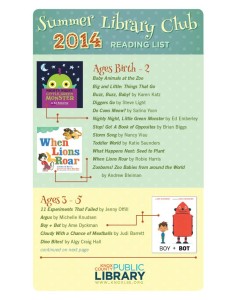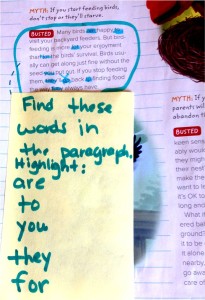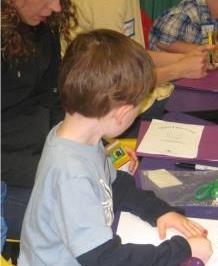 Over the summer, it is easy to get into summer mode and forget to keep up reading practice. Here are a few fun ways to keep up your child’s practice so that reading skills will be remembered when school begins:
Over the summer, it is easy to get into summer mode and forget to keep up reading practice. Here are a few fun ways to keep up your child’s practice so that reading skills will be remembered when school begins:
1.) With extra time in your child’s summer schedule, make regular visits to your library. Have your child join the reading challenges many public libraries offer — to read a number of books for a reward. Many public libraries offer lists of books appropriate for your child’s age and developmental stage. Make your library visits a fun way to explore different types of books and book genres.
 2.) Use children’s magazines like Highlights to create opportunities for your child to find specific words in articles. (Please click here to read my review of magazines for your child.) In your chosen magazine, make a list of word that your child is learning. Ask your child to find and highlight all of the listed words in a paragraph that you have circled. Your child can use all kinds of different colored highlighters to make searching for the words more fun. This is a great way to help your child practice their sight words like “is” and “was” or word families like “hat” and “mat”. Finding words that rhyme is another great variation on this word search game – for example, finding calf and laugh in an article or circled paragraph about a farm girl and her animals.
2.) Use children’s magazines like Highlights to create opportunities for your child to find specific words in articles. (Please click here to read my review of magazines for your child.) In your chosen magazine, make a list of word that your child is learning. Ask your child to find and highlight all of the listed words in a paragraph that you have circled. Your child can use all kinds of different colored highlighters to make searching for the words more fun. This is a great way to help your child practice their sight words like “is” and “was” or word families like “hat” and “mat”. Finding words that rhyme is another great variation on this word search game – for example, finding calf and laugh in an article or circled paragraph about a farm girl and her animals.
 3.) Help your child start a book club. Have your child write down the titles of favorite books on note cards and then a short sentence about what he or she liked about each book. For example, “It had a cat and dog in the story.” Your child can illustrate the sentence on the note card as well. Then have your child share the cards with her friends. At play dates with friends, they can exchange cards to suggest books to read. This is a great way for friends to share their excitement for well-loved books.
3.) Help your child start a book club. Have your child write down the titles of favorite books on note cards and then a short sentence about what he or she liked about each book. For example, “It had a cat and dog in the story.” Your child can illustrate the sentence on the note card as well. Then have your child share the cards with her friends. At play dates with friends, they can exchange cards to suggest books to read. This is a great way for friends to share their excitement for well-loved books.
Here are three fun ways to keep your child’s reading on track for the summer.
What are ways you help keep your child practicing his reading throughout the summer?









